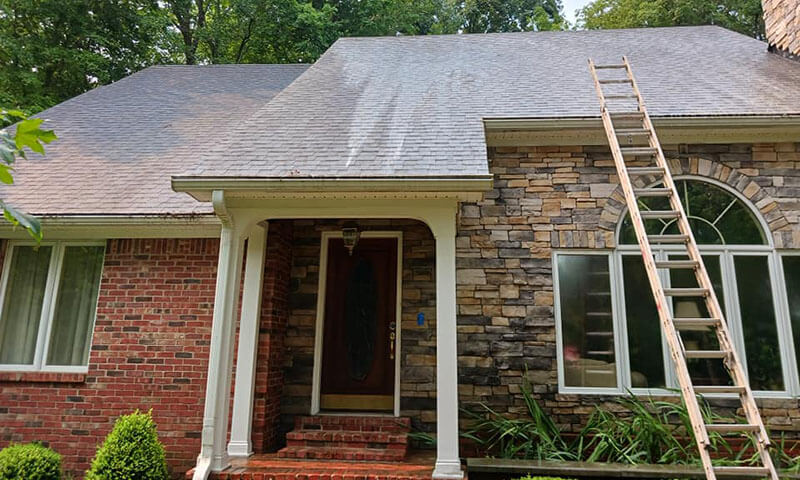Yes, algae do damage the roof. This is the question I face most frequently in monsoon. Unfortunately, it’s a fact that algae damage roof shingles in many ways. Algae have structural, apparent, attributable effects on roof shingles. Besides, it makes repair work more difficult and time-consuming.
As a contractor, I feel the algae problem is a reality for a house owner. So, today I will talk about it in detail and discuss its possible solutions. Stay with me.
Quick Jump
How do algae damage roof shingles?

Algae grow on house roofs or walls because they get everything necessary to survive here. They intake minerals from limestone to fulfilling their demand for food. Besides, they soak all moisture from the shingles. As a result, various types of damage occur in shingles. Let me elaborate.
- Structural damage: As I said earlier, algae slowly eat out the limestone from the shingles. Thus, the structure of the shingles becomes weak. They become fragile and crack in various places. As a result, you will find roof leakage and breakage.
- Appearance damage: It’s easy to understand that algae don’t look good on shingles. If you don’t clean the shingles regularly, a dark layer of algae develops on them. Sometimes it doesn’t fade away, even after washing. Thus, the color of the shingles changes, and their glace disappears slowly.
- Attribute damage: Algae also change some important attributes of the shingles. For example, they damage the reflective nature of the shingles. As I said earlier, algae change the appearance of the shingles and make them darker. Consequently, the shingles fail to reflect the sunlight and absorb more heat. Thus, the roof heat increases.
- Other damages: Alongside these physical damages, algae have other effects on the shingles. For example, it makes roof maintenance work difficult. Because the roof becomes too slippery when there is algae on them.
Preventive ways to avoid algae on roof shingles

Algae spores are microorganisms. They are so small that you can’t see them with bare eyes. It’s too easy for them to travel through the wind. So, you can stop algae from spreading on your roof. What you can do is stop or control its growth. Here is how you can do it.
- Sunlighting and cleaning: Algae generally grows on wet and dark surfaces. So, you must keep the roof dry and clean to prevent their growth. If there are trees around your house, trim their stem. Thus, you can supply enough sunlight to keep the roof dry. It won’t burn out the existing algae but prevent growing new ones. Also, keep the roof clean so no bacteria or algae can grow there.
- Use algae-resistant shingles: If you are damn serious about algae, using algae-resistant shingles can help. This type of shingles has 3 layers. There are copper and ceramic layer to save the mineral from the algae. So, it’s difficult for algae to survive if algae-resistant shingles are on your roof.
How to remove algae from roof shingles

Although you take preventive steps, you can’t completely prevent algae growth in the shingles. Besides, these steps won’t work if algae already exist on your house roof. So, learn how to remove it permanently.
- Brushing & Rinsing: Fortunately, removing algae from the house roof is too easy. Simply brush them off and rinse them with clean water. Doing it 3/4 times can remove algae to some extent. However, there still can be a black layer remaining on the shingles. For that, you have to apply bleach for better results.
- Bleaching: If the shingles’ algae don’t remove after brushing and rinsing, apply bleach. You have to prepare a solution of 50% chlorine bleach with water. Then throw it through the roof and wait for a few minutes. Chlorine will kill off the algae after a while. Now, perform brushing and rinsing. I hope the algae will get removed completely.
- Professional help: The above process is time-consuming and painful at the same time. So, you may want to skip it. In this case, you should hire professional roof cleaners for the job. They will come with automatic roof-cleaning tools and chemical that works better. Thus, they do the job faster and more efficiently.
- Use zinc strips: It’s the step to prevent further algae growth after cleaning them. You can find zinc strips online or at any hardware shop. Just attach them on the top sides of the roof, and rain will do the rest. Zinc will be washed out with the rain and react with algae spores to stop their growth.
Frequently asked questions about algae and shingles
What color roof hides algae?
Algae generally have a dark greenish-black appearance. So, any dark color roof can hide algae. Moreover, dark colors absorb more heat. High temperatures prevent the algae from growing. So, a dark color roof is best against algae.
Are all shingles algae-resistant?
Not at all. Actually, the most popular type of shingle is asphalt. It has limestone, which is a primary food source of algae. Thus, algae eat out the limestone from most of the shingles. So, most of the shingles are not algae-resistant. However, you will find a special type of shingle that can resist algae. But they are not widely available in the market.
How long do roof shingles last?
Despite algae attacks, roof shingles can last for 10 to 30 years. It actually depends on the material and construction. For example, build-up asphalt shingles last for 10 to 20 years. Whereas plain slope roofs can survive more than 25 years. However, organic shingles deteriorate earlier than the inorganic ones.
Conclusion
Honestly, it’s impossible to avoid the algae problem by actual means. But you can control its growth and eliminate its effect to some extent. That much can help to save the shingles from damage.
However, there is a sequential process I have described earlier in this blog. Before that, I also explained the problem thoroughly. Hope that has helped to understand the algae problem and find its remedies. Even after that, if you have any queries, comment below. I will try to answer them.
Cheers!

Roger Lewis is an experienced roof repair contractor with over 15 years of industry experience. He is known for his expertise in all aspects of roof repair, including leak detection, shingle replacement, and gutter repair.
